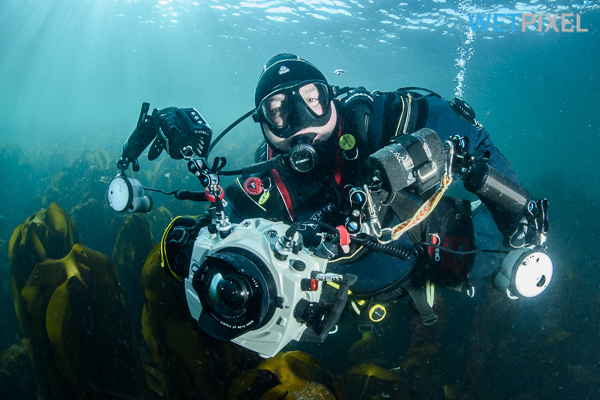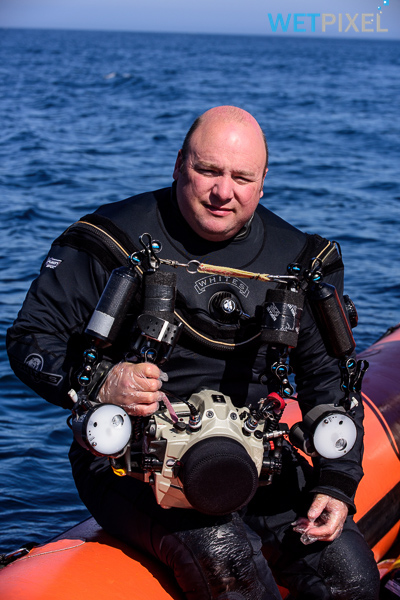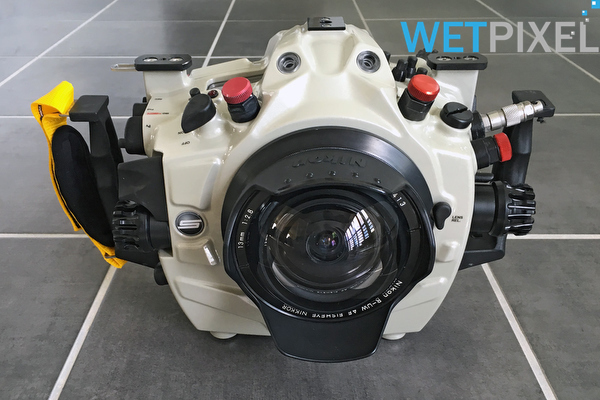Alex Mustard: Nikon D5 First Thoughts

Nikon D5 First Thoughts.
By Alex Mustard.
Normally when an important new Nikon SLR is released I am chomping on my mouthpiece to review it for Wetpixel. While flagship cameras, like the Nikon D5, are not used by many underwater photographers, they are the most interesting to review because they introduce new specs and tech that soon appears in other models. However, the arrival of Nikon D5 coincided with that of my daughter and 5 months after the release of the camera I have only just started using it underwater (although I did take the very first photo of her with it, which is far more valuable!). So instead of a detailed review Adam suggested that I share a few of my first impressions and some images in a Full Frame feature.

I will also share a few early thoughts on how the camera performs underwater. However, these are very much “first impressions” only. I have made just a handful of dives and only shot the camera in low visibility conditions of England, on an assignment focused on grey seals (at Lundy Island and the Farne Islands).
My point of reference for the D5 is its predecessor the D4. I accept that the Nikon D4 is not that well known by underwater photographers and its capabilities were missed by many in the hubbub created by the headline grabbing D800, that was released at the same time. But everyone I know who had a D4 (and most also had a D800) soon appreciated why Nikon charged more than two D800s for it. Nikon designs these cameras as go anywhere-shoot anything-in any conditions-machines and the Nikon D5 is based on the same philosophy. It is just a clear generation further on in performance.
These cameras are designed to get the shot when it matters for photojournalists. That means high frame rates, amazing autofocus, wide ISO ability. The spec sheets tell you that. What you only realize when you own them, is that the D4 and the D5 have a tremendous adjustability in post, even in shots taken at high ISO values. With the D5, amazing detail can be restored from both shadow and highlight allowing the camera to capture a very wide dynamic range at all ISOs. I have found that sunbursts are captured well even at higher ISO values.
Underwater photographers deal with much greater color shifts than almost all other photographers. I have falsely heard many state that it does not matter how a camera captures color, it can all be corrected to be the same in post. I do not find this true underwater, different cameras capture color differently and different cameras have different adjustability in post. The D5 (and D4) have large sensors with relatively few photosites (pixels) and to me this clearly helps the colors. D4 owners always comment about how they are able to correct and restore color in their images. The D5 is just as good, perhaps better (I need to dive it more to firm up that conclusion).

The most obvious jump when coming to this camera from Nikon D4 is the autofocus. The Nikon D4 is no slouch, but the D5 moves the game on significantly. I have not found the new grouped AF modes that valuable (despite lamenting their loss when the disappeared in the D2-D3 transition). On this shoot, I just used AF-C AUTO area focus throughout, because it worked 100% of the time. Even in low light, even in very poor visibility, even against the sun: Everything is in focus. I even did a macro dive and left it on with the SMC (no torch at 18m/60ft in the UK) and it worked, although switched to 3D tracking after a while. That said, I have done very little macro so far, but I am really excited to get this camera to Lembeh at the end of September for the Wetpixel Macro Workshop to experiment further with the AF (Adam should be reviewing the D500, so we will be able to compare notes).

The stylish Subal ND5 housing has performed faultlessly, which leaves me little to say. Every function performing perfectly from the first time I loaded the camera. I’d like to thank Subal for getting it to me in just 3 days when this shoot came up. A feature I really liked on my D4, which carries over to the D5 is the ability to assign Fn2 button to be Flash Off. This button is accessed by a lever under your right index finger (right middle finger does the shutter, just below). This is a great way to instantly shoot available light pictures, such as the silhouettes below, without having to fiddle with strobes in gloves.

A step back on the D5 (and D500, which is similarly afflicted) is that Nikon have moved the ISO button to be near the shutter on the right side of the camera. This is an annoying position for housing manufacturers as this side of a housing is already cluttered. As a result, the all important ISO button is less convenient to access on all the D5 housings I have seen so far than on it was D4 housings. I hope that Nikon will provide a firmware update that will allow another button (such as WB) to be changed to ISO in the custom settings in future (Editor’s note: Nikon are aware of this).
I have given the camera settings for the images. You will note that I am often changing ISO, however sunny weather meant that despite the low visibility I didn’t need to use many 4 figure ISO values. Aperture stays at or above the magic f/13 on full frame most of the time. I tend to use apertures around this value for CFWA shots with the Nikonos 13mm, because I don’t like the shallow depth of field look it produces if I don’t.
The question I have been asked the most is about is nothing to do with the Nikon D5 nor is specific to Subal, and instead is about the functionality of the UW Technics optical TTL converter that many housing manufacturers are now fitting to housings (Subal, Nauticam (Editor’s note: In conversation with Nauticam UA, they have a bespoke variant of the standard UW Technics converter fitted), BS Kinetics all offer it). This circuit allows cameras without a pop-up flash to work with fibre-optic synch cords, or cameras with a pop-up flash not to be limited by its recycle/overheating time. In my rush to get the housing for my shoot, I did not have this fitted. I shall make sure I have one before publishing a full review (the ND5 housing already has the optical ports).
To see some of Alex’s images taken with the new camera, please visit his Full Frame feature.